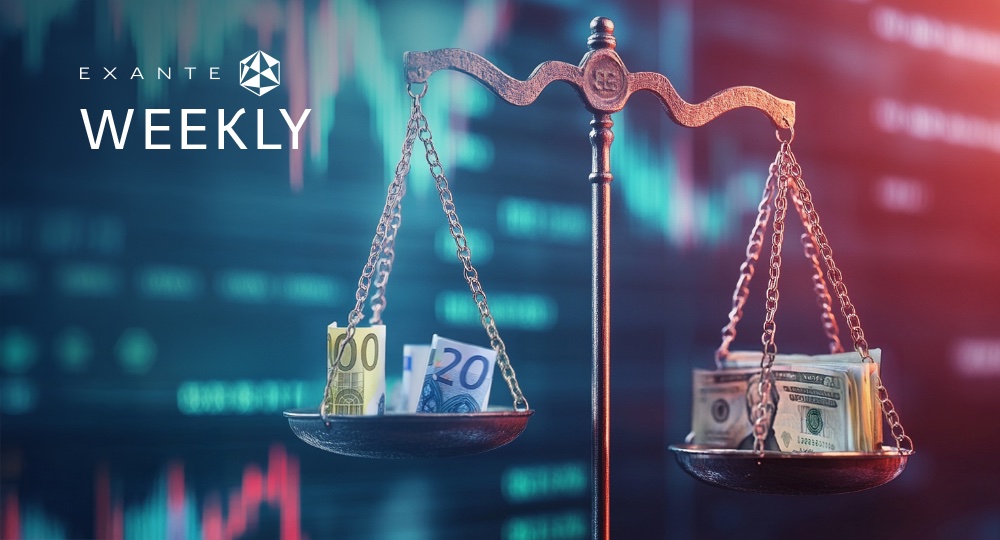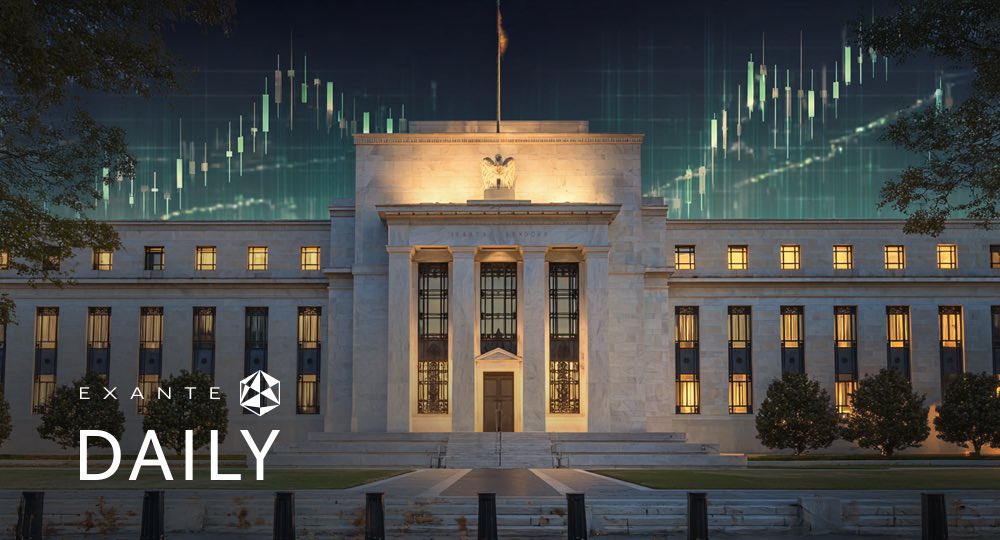
Holding the line for longer

- Global market indices
- Currencies
- Cryptocurrencies
- Fixed Income
- Commodity sector news
- Key data to move markets this week
- Global macro updates
US Stock Indices
Nasdaq 100 -5.19% MTD and +34.33% YTD
Dow Jones Industrial Average -0.81% MTD and +3.90% YTD
NYSE -2.49% MTD and +2.75% YTD
S&P 500 -2.34% MTD and +14.66% YTD
Mega caps: A very poor week for the mega caps as markets worried about the potential impact on consumer demand of another rate rise in the near future and the “higher for longer” scenario put forward by the Fed. Apple, Alphabet, Amazon, Meta Platforms, Tesla, Microsoft, and Nvidia are all down this week. Microsoft fell after internal documents detailing the company’s plans for its Xbox and gaming unit were leaked on Wednesday, however it may get a boost from the UK’s Competition and Markets Authority agreeing to consult on a new offer around Microsoft's $69 billion Activision Blizzard Inc. According to Bloomberg news, the new proposal includes an offer to sell some gaming rights to French publisher Ubisoft Entertainment SA. Amazon was down 4.41% on Thursday on news that the company has decided to not charge a fee to merchants who don't use its shipping services, a possible response to a Federal Trade Commission's (FTC) antitrust investigation and concerns around how another Fed hike later this year could weigh on growth.
Energy stocks had a bad week despite the jump up in oil prices as US interest rate hike expectations offset the impact of tightening supplies. Apa Corp (US), Chevron, Baker Hughes, Exxon Mobil, Marathon Petroleum, ConocoPhillips, Phillips 66, Occidental Petroleum, Shell, Halliburton, and Energy Fuels are all down this week.
Materials and Mining stocks were mixed this week as a stronger USD hit metals prices with copper continuing to suffer from rising inventories and tin stocks continuing to feel weakened demand. Yara International, Freeport-McMoRan, Nucor Corporation, Albemarle Corporation, CF Industries Holdings, Mosaic, and Sibanye Stillwater are all down, while Newmont Mining is slightly up.
European Stock Indices
Stoxx 600 -0.77% MTD and +7.01% YTD
DAX -2.35% MTD and +11.84% YTD
CAC 40 -1.40% MTD and +11.43% YTD
IBEX 35 +0.45% MTD and +16.04% YTD
FTSE MIB -0.43% MTD and +21.10% YTD
FTSE 100 +3.22% MTD and +3.04% YTD
European stocks were lower this week as investors appeared to fear an extended period of higher interest rates in the Eurozone and in the UK will curb economic demand.
According to LSEG I/B/E/S data, second quarter earnings are expected to decrease 5.8% from Q2 2022. Excluding the Energy sector, earnings are expected to increase 10.1%. Second quarter revenue is expected to decrease 6.0% from Q2 2022. Excluding the Energy sector, revenues are expected to increase 0.6%. Of the 293 companies in the STOXX 600 that have reported earnings as of 19 September for Q2 2023, 51.5% reported results exceeding analyst estimates. In a typical quarter 54% beat analyst EPS estimates.
Other Global Stock Indices
MSCI World Index -1.59% MTD and +11.54% YTD
Hang Seng -3.95% MTD and -10.75% YTD
Currencies
The USD once again strengthened this week as the Fed made clear that it will be higher rates for longer, with only two rate cuts now anticipated in 2024, down from June’s projections of four cuts. The GBP is +1.67% YTD but -2.97% MTD against the USD. Sterling came under pressure on Thursday falling to the weakest level since March, after data on Wednesday showed Britain's high inflation rate fell unexpectedly in August and the BoE’s decision to hold rates at 5.25% on Thursday. The EUR is -0.41% YTD and -1.69% MTD against the USD as stagnant economic growth in the Eurozone and the belief that the ECB will have to cut rates before the Fed appear to be concerning traders. The sharp rise in oil prices is also weighing on valuations.

Cryptocurrencies
Bitcoin +2.23% MTD and +60.36% YTD
Ethereum -3.68% MTD and +32.45% YTD
Cryptocurrencies continue to be hit by the strength of the USD and expectations of “higher for longer” by key central banks. Although the Fed announced a pause in its rate hiking cycle on Wednesday, it raised its projected interest rates for the end of 2023 to 5.6%, indicating another rate hike to come this year. It also raised its projection for the end of 2024 to 5.1%, up from the 4.3% predicted in June. Cryptocurrencies are also being affected by the SEC’s determination to continue its regulatory scrutiny of brokers, dealers and clearing agencies.
Fixed Income
US 10-year yield to 4.48%.
German 10-year yield to 2.74%.
UK 10-year yield to 4.30%.

Interest rate sensitive two-year US Treasury yields reached their highest in 16 years on Thursday after the Fed held interest rates steady on Wednesday, but strengthened its hawkish stance for future policy. The new quarterly Fed projections indicate a further rate increase by the end of the year and expected monetary policy to be significantly tighter through 2024 than previously suggested in June. UK Gilt yields dropped on Wednesday as there was a sharp repricing of the futures curve after CPI slowed to 6.7% in August from 6.8% in July and below the 7% widely expected. Following the BoE’s decision to hold rates on Thursday, the UK’s bond market rebounded with Gilt yields falling even further, with the 10 year benchmark falling below the US level for the first time since March.
Commodities
Gold futures to $1,939.60 an ounce.
Silver futures to $23.69 per ounce.
West Texas Intermediate crude to $89.63 a barrel.
Brent crude to $93.30 a barrel.
Oil prices fell to a one-week low on Wednesday after the Fed kept interest rates unchanged but maintained its hawkish stance with a further rate increase projected by the end of the year. Oil was up overall this week as fears grew over falling supplies from Saudi Arabia and Russia. Falling US crude stocks, down by 2.1 million barrels in the week ending 15 September, has also concerned traders. With Brent up about 30% over the past two months to its highest point this year, there are growing concerns about the inflationary impact this may have in terms of creating a second wave of inflationary pressures that could challenge central banks in the months ahead.
Gold extended its decline for the third straight session on Thursday, as the USD and Treasury yields rallied after the Fed warned on Wednesday that an additional rate hike was on the cards. Upward price momentum may not resume until it is clear that the Fed is either going to hold or cut rates and the USD softens. Central bank demand for gold will continue to be supportive.
Note: As of 5 pm EDT 21 September 2023
Key data to move markets this week
EUROPE
Friday: Spanish GDP, German HCOB Composite, Manufacturing and Services PMIs, and Eurozone HCOB Composite, Manufacturing, and Services PMIs.
Monday: German IFO Business Climate, Current Assessment and Expectations.
Wednesday: German Gfk Consumer Confidence Survey.
Thursday: Spanish Harmonised Index of Consumer Prices, ECB Economic Bulletin, Eurozone Business Climate, Economic Sentiment and Consumer Confidence surveys, German CPI, and German Harmonised Index of Consumer Prices.
UK
Friday: Retail Sales and S&P Global/CIPS Composite, Manufacturing, and Services PMIs.
US
Friday: S&P Global Composite, Manufacturing and Services PMIs.
Monday: Chicago Fed National Activity Index.
Tuesday: Housing Price Index, S&P/Case-Shiller Home Price Indices, New Home Sales Change and Consumer Confidence.
Wednesday: Durable Goods Orders, Nondefense Capital Goods Orders, and EIA Crude Oil Stocks Change.
Thursday: Initial Jobless Claims, GDP, Core Personal Consumption Expenditures Index, Personal Consumption Expenditures Prices, and Pending Home Sales.
Global Macro Updates
The Fed’s no holds barred approach. Despite keeping rates on hold this month at a range of 5.25-5.50%, the Fed is projecting another rate rise this year with the new quarterly projections showing that 12 of 19 officials want another rate hike in 2023. Its new “dot plot” projections indicate that there will be 50 bps of cuts in 2024 but that inflation won’t approach the 2% target rate until the end of 2025. Fed officials now see the personal consumption expenditures price index at 3.3% at year end, up from June's forecast of 3.2%, and its overnight lending rate to be 5.1% at the end of 2024, about 50 basis points higher than futures have projected. Fed Chair Jerome Powell said officials are “prepared to raise rates further if appropriate, and we intend to hold policy at a restrictive level until we’re confident that inflation is moving down sustainably toward our objective.”
The economy continues to remain resilient with initial jobless claims falling to 201,000 last week, the lowest level since January, indicating a healthy labour market that continues to support the economy. However, existing home sales unexpectedly fell in August as persistently tight supply boosted prices, and a further decline is likely amid a resurgence in mortgage rates. And, as noted by Bloomberg news, there is the risk of growth in Q4 being slowed by a triple threat: the auto workers strike, a possible government shutdown and the scheduled resumption of student loan repayment by 28 million borrowers. That resilient economy and much anticipated soft landing scenario may still result in below-trend growth as the impacts of higher interest rates and tighter lending standards, lower excess savings and, eventually, weakening job growth feed through the economy.
Has the BoE peaked? The Bank of England held its key rate at 5.25%, ending a series of 14 successive hikes since December 2021. Five members of the Monetary Policy Committee voted to leave rates unchanged and four wanted to raise them to 5.5%. Governor Andrew Bailey, who had the casting vote, chose to hold. With inflation in August coming in below expectations at 6.7% from July’s 6.8%, the Bank of England is very likely, as its Governor Andrew Bailey said a few weeks ago, at its peak. Underlying inflation data also fell more significantly than expected as well. Core CPI came in at 6.2% in August, down from 6.9% in July and annual services CPI inflation fell to 6.8% in August from 7.4% in July. UK consumer confidence jumped by 4 points to -21 in September, the highest since January 2022, according to a report by GfK. According to Bloomberg news, wage growth is beginning to outpace inflation, which is likely helping ease the financial burden of consumers.
The BoE has signalled that policy was only on pause and it would respond if inflation doesn’t fall as expected. The committee said rates would be “sufficiently restrictive for sufficiently long” and “further tightening in monetary policy would be required if there were evidence of more persistent pressures.” The MPC forecasts consumer-price inflation to hit the target in Q2 of 2025. There were no suggestions of a cut in interest rates in the near term. The BoE cut its forecast for economic growth in the July-September period to just 0.1% from August's forecast of 0.4% and noted clear signs of weakness in the housing market. It also said that growth for Q4 was likely to be weaker than previously forecast. The market repricing is weighing on Sterling and government bonds have rallied. However, despite headline inflation falling, there is still the concern that the economy is slowing, that wages are still rising at a record pace, threatening attempts to bring inflation down, and the full impact of previous rate hikes may still not have fed fully through the economy. What is clear is that with inflation still more than double the target, rates will have to stay higher for longer.

It ain’t easy being green. UK Prime Minister Rishi Sunak announced on Wednesday that the UK government would delay a ban on sales of new petrol and diesel cars until 2035 from 2030, ease the transition to heat pumps from gas boilers in homes, and that households would not be forced to improve their insulation. Sunak said he remained committed to the legally-binding target of reaching net zero emissions by 2050 but said Britain could afford to make slower progress in getting there because it was "so far ahead of every other country in the world."
Worries over the cost of the green transition as high inflation and concerns over the cost of these green reforms may have on economic growth are leading to a backlash in some European countries. According to Bloomberg news, 8 countries in the EU, including France and Italy, want to weaken so-called Euro 7 rules that aim to cut pollution from cars and are set to come into force from 2025. These countries say that focusing on this emission rule means that they would not be able to structure their investment enough to be able to compete with cheap Chinese electric vehicles (EVs).
DISCLAIMER: This article is provided to you for informational purposes only and should not be regarded as an offer or solicitation of an offer to buy or sell any investments or related services that may be referenced here.
While every effort has been made to verify the accuracy of this information, EXT Ltd. (hereafter known as “EXANTE”) cannot accept any responsibility or liability for reliance by any person on this publication or any of the information, opinions, or conclusions contained in this publication. The findings and views expressed in this publication do not necessarily reflect the views of EXANTE. Any action taken upon the information contained in this publication is strictly at your own risk. EXANTE will not be liable for any loss or damage in connection with this publication.
This article is provided to you for informational purposes only and should not be regarded as an offer or solicitation of an offer to buy or sell any investments or related services that may be referenced here. Trading financial instruments involves significant risk of loss and may not be suitable for all investors. Past performance is not a reliable indicator of future performance.




